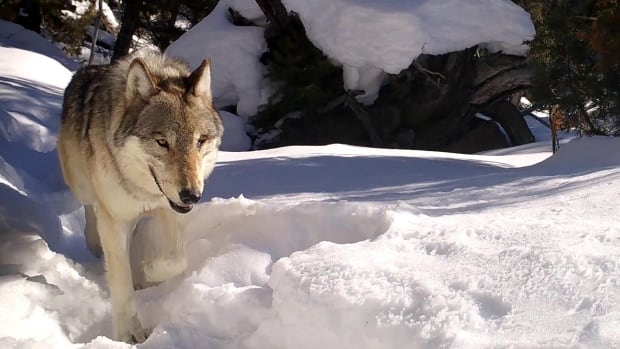As It Happens6:34This elderly, 1-eyed wolf keeps going strong and having pups. And she’s the leader of her pack
Wolf 907F is a shrewd survivor, a wise elder, a prolific mother — and an absolute boss.
The one-eyed alpha female at Yellowstone National Park has blown scientists away by living long past her life expectancy, while continuing to be healthy enough to produce annual litters of pups.
“I think she’s a very fascinating wolf,” Kira Cassidy, a research associate at the Yellowstone Wolf Project, told As It Happens host Nil Köksal.
“She has persisted for so long. It’s like three or four times longer than most wolves live. And she just seems to be such a steadfast feature out there.”
She has Canadian roots
The Yellowstone Wolf Project has been monitoring grey wolves at the U.S. national park in Wyoming and parts of Montana since 1995, when the animals were first reintroduced to the area.
Before the arrival of settlers, wolves roamed the wilderness there for thousands of years, playing a key role in the ecosystem. But by the late 1920s, the population had been eradicated. They were hunted, along with other predators, with the encouragement of the U.S. government, in the name of taming the wold and protecting livestock.
“Along with the removal of other carnivores, like cougars and bears, this action had a profound effect on Yellowstone. In the absence of carnivores, elk numbers boomed, which resulted in significant changes in vegetation. Beavers became increasingly rare, and food web dynamics were significantly altered,” reads the Yellowstone Wolf Project’s website.

But three decades ago, wolves returned to Yellowstone.
It began with 14 wolves, captured from the Canadian wilderness, in 1995. A year later, 17 more Canadian wolves were introduced. Then 10 more from northwestern Montana in 1997.
Today, the park is home to more than 100 wolves, divided into 10 packs.
But none are quite like 907F.
She’s never been a lone wolf
First, she’s 11 years old. Yellowstone wolves are considered elderly at six, says Cassidy, and most never make it that far. On average, she says, they live three or four years.
She is the sixth park wolf to make it to age 11 out of what has, at this point, been several thousand wolves.
What’s more, she keeps having puppies each spring and is currently nursing her 10th litter.
That, in and of itself, is not that unusual. Wolves don’t go through menopause, so they can keep reproducing, albeit with smaller litters as they age.
“But it does show also that she was able to get enough food during the winter, and she had a healthy gestation. She has enough fat and she is strong enough to lactate and provide the milk,” Cassidy said. “So overall, it seems like she’s still very healthy.”

She’s been the leader of her pack since she was three — a role she inherited from her aunt, who died.
“She is one of probably only a few wolves that never had to disperse and leave her home territory to start a new pack,” Cassidy said. “That helps quite a lot. She didn’t have to go through that alone period, trying to find a new place to live.”
Her pack currently has about 10 wolves — eight adults, and her two newest pups — which is about average. But it has, at various points, been particularly populous. In 2020, her pack reached a peak of 35 members.
Having that many pack mates lowers 907F’s chances of getting killed by a wolf from another pack, which Cassidy says is the No. 1 cause of mortality for Yellowstone wolves.

Being in charge has its advantages, too.
“She also, at this age, lets her younger pack mates hunt large prey. And so she is not really in danger of being kicked by an elk or a bison,” Cassidy said. “But once they make kills, she goes and feeds. She’s still the alpha or the leader of her pack, so they look to her as the boss.”
And with good reason. 907F knows her territory well — the best places to cross a river or a road, or how to avoid humans, for example.
“There are probably many different kinds of subtle things that she has learned how to navigate that have increased her odds of survival,” Cassidy said.

But 907F does have one disadvantage. When she was four, one of her eyes stopped working.
The researchers don’t know how it happened, but Cassidy says she’s seen the sunken eye up close while 907F was sedated to have her tracking collar replaced. (She keeps outliving the batteries.) And infrared light from night-time wildlife camera footage makes no reflection on the bad eye, confirming it’s dead.
“Had I not seen those things, I would never believe that she only has one eye, because as we’re watching her with binoculars or spotting scope, it doesn’t seem like her behaviour or her movements are different from any of the other wolves,” Cassidy said.
Cassidy has been monitoring 907F since the wolf was a pup, and every year she expects to get a notice from her tracking collar that she’s no longer moving.
But, so far, she’s still going strong.
“She surprises me all the time,” Cassidy said.







